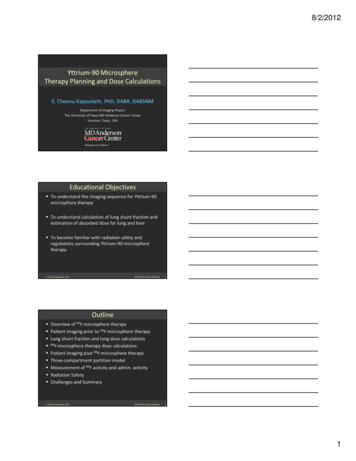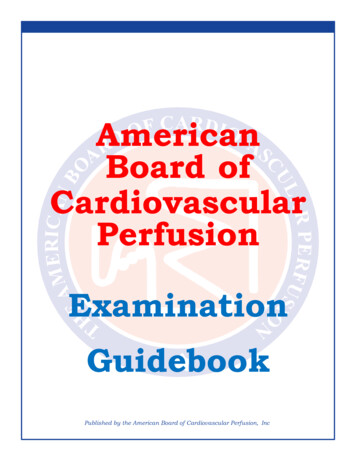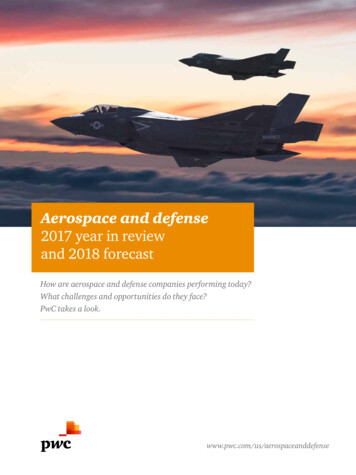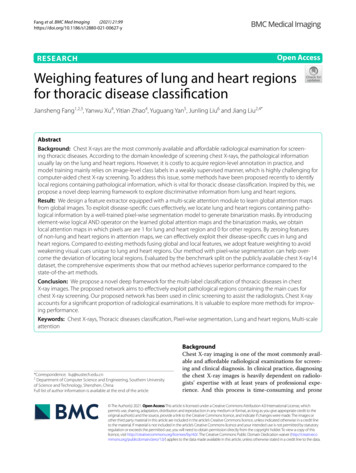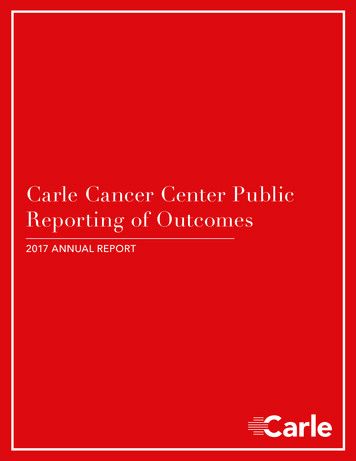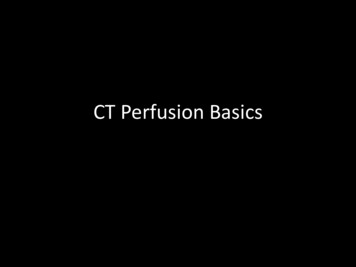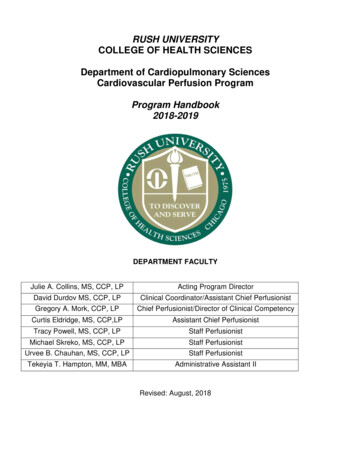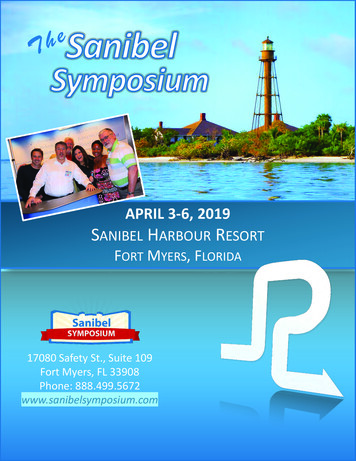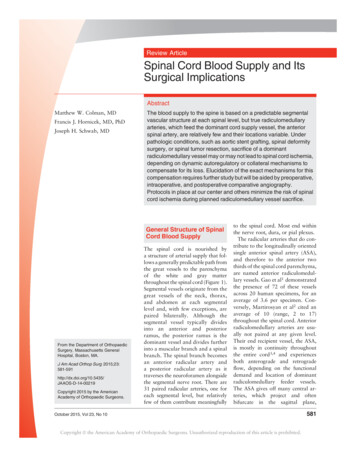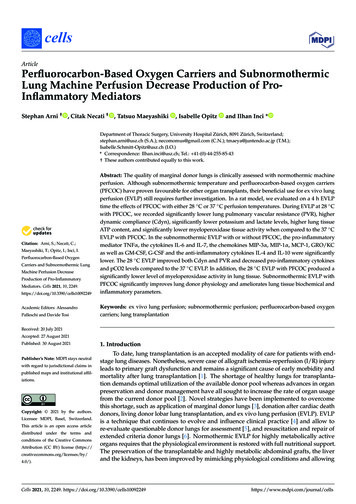
Transcription
cellsArticlePerfluorocarbon-Based Oxygen Carriers and SubnormothermicLung Machine Perfusion Decrease Production of ProInflammatory MediatorsStephan Arni † , Citak Necati † , Tatsuo Maeyashiki, Isabelle Opitzand Ilhan Inci *Department of Thoracic Surgery, University Hospital Zürich, 8091 Zürich, Switzerland;stephan.arni@usz.ch (S.A.); necomomus@gmail.com (C.N.); tmaeya@juntendo.ac.jp (T.M.);Isabelle.Schmitt-Opitz@usz.ch (I.O.)* Correspondence: Ilhan.inci@usz.ch; Tel.: 41-(0)-44-255-85-43† These authors contributed equally to this work. Citation: Arni, S.; Necati, C.;Maeyashiki, T.; Opitz, I.; Inci, I.Perfluorocarbon-Based OxygenCarriers and Subnormothermic LungMachine Perfusion DecreaseProduction of Pro-InflammatoryMediators. Cells 2021, 10, 2249.https://doi.org/10.3390/cells10092249Academic Editors: AlessandroPalleschi and Davide TosiAbstract: The quality of marginal donor lungs is clinically assessed with normothermic machineperfusion. Although subnormothermic temperature and perfluorocarbon-based oxygen carriers(PFCOC) have proven favourable for other organ transplants, their beneficial use for ex vivo lungperfusion (EVLP) still requires further investigation. In a rat model, we evaluated on a 4 h EVLPtime the effects of PFCOC with either 28 C or 37 C perfusion temperatures. During EVLP at 28 Cwith PFCOC, we recorded significantly lower lung pulmonary vascular resistance (PVR), higherdynamic compliance (Cdyn), significantly lower potassium and lactate levels, higher lung tissueATP content, and significantly lower myeloperoxidase tissue activity when compared to the 37 CEVLP with PFCOC. In the subnormothermic EVLP with or without PFCOC, the pro-inflammatorymediator TNFα, the cytokines IL-6 and IL-7, the chemokines MIP-3α, MIP-1α, MCP-1, GRO/KCas well as GM-CSF, G-CSF and the anti-inflammatory cytokines IL-4 and IL-10 were significantlylower. The 28 C EVLP improved both Cdyn and PVR and decreased pro-inflammatory cytokinesand pCO2 levels compared to the 37 C EVLP. In addition, the 28 C EVLP with PFCOC produced asignificantly lower level of myeloperoxidase activity in lung tissue. Subnormothermic EVLP withPFCOC significantly improves lung donor physiology and ameliorates lung tissue biochemical andinflammatory parameters.Keywords: ex vivo lung perfusion; subnormothermic perfusion; perfluorocarbon-based oxygencarriers; lung transplantationReceived: 20 July 2021Accepted: 27 August 2021Published: 30 August 2021Publisher’s Note: MDPI stays neutralwith regard to jurisdictional claims inpublished maps and institutional affiliations.Copyright: 2021 by the authors.Licensee MDPI, Basel, Switzerland.This article is an open access articledistributed under the terms andconditions of the Creative CommonsAttribution (CC BY) license (https://creativecommons.org/licenses/by/4.0/).1. IntroductionTo date, lung transplantation is an accepted modality of care for patients with endstage lung diseases. Nonetheless, severe case of allograft ischemia-reperfusion (I/R) injuryleads to primary graft dysfunction and remains a significant cause of early morbidity andmortality after lung transplantation [1]. The shortage of healthy lungs for transplantation demands optimal utilization of the available donor pool whereas advances in organpreservation and donor management have all sought to increase the rate of organ usagefrom the current donor pool [2]. Novel strategies have been implemented to overcomethis shortage, such as application of marginal donor lungs [3], donation after cardiac deathdonors, living donor lobar lung transplantation, and ex vivo lung perfusion (EVLP). EVLPis a technique that continues to evolve and influence clinical practice [4] and allow tore-evaluate questionable donor lungs for assessment [5], and resuscitation and repair ofextended criteria donor lungs [6]. Normothermic EVLP for highly metabolically activeorgans requires that the physiological environment is restored with full nutritional support.The preservation of the transplantable and highly metabolic abdominal grafts, the liverand the kidneys, has been improved by mimicking physiological conditions and allowingCells 2021, 10, 2249. dpi.com/journal/cells
Cells 2021, 10, 22492 of 12the continuous elimination of toxic products from the cellular medium while carrying outan active restoration of ATP reserves and glycogen [7,8]. Signs of oxidative and inflammatory stress have been monitored in liver perfusate with metabolomics and principalcomponent analysis approaches [9]. Researchers have also suggested how the initial phaseof hypothermic oxygen infusion soon after graft removal promoted the reduction of wastes,such as succinates, which typically accumulate in the graft during static storage, and havedeveloped protocols that have allowed the restoration of mitochondrial ATP levels, reducedNADH/NAD ratio, a decrease in lactate, succinate and purine derivatives [7,10]. Althoughcold storage at 4 C reduces the lung tissue metabolic rate, the metabolism is not fullyput to a complete rest due to the decreased metabolic rate [11]. The main reasons behindperforming lung subnormothermic or hypothermic machine perfusions are to mitigatedamages due to I/R injury [12], to decrease production of reactive oxygen species (ROS),and to reduce carbon dioxide production and, consequently, decrease the requirement forminute ventilation. Moreover, the use before transplantation of hypothermic oxygenatedmachine perfusion has been reported to preserve kidneys and livers with better resultsthan cold static storage [13]. Oxygenated ex vivo perfusions were successfully tested at22 C in porcine kidneys with hemoglobin-based oxygen carriers [14] and at 4 C in donorrat livers with perfluorocarbon-based oxygen carriers (PFCOC) [15]. PFCOC have beendeveloped to mimic blood oxygen transport properties and have relatively short half-life(12–24 h) but ex vivo organ machine perfusion studies showing clear benefits for the use ofPFCOC are still scarce [16]. PFCOC are chemically and biologically inert and can dissolvelarge amounts of oxygen, carbon dioxide, and other gases [17,18]. As perfluorocarbonare immiscible in water they have to be emulsified for intravascular administration inhuman clinical trials [19]. PFCOC are emulsions taking advantage of the high solubility ofrespiratory gases in perfluorocarbons [19]. Due to the small size (0.1–0.2 microns versus7–8 microns), PFCOC emulsion particles mainly flow in the peripheral plasma layer inlarger vessels. PFCOC perfuses even the tiniest capillaries, where no red blood cells mayflow under certain conditions (i.e., micro blood clots) in the microcirculation. With PFCOC,there is no saturation and no possibility for chemical binding and interferences with carbonmonoxide, nitric oxide and other reagents. With PFCOC present in the lung microcapillaries, the oxygen is released and the carbon dioxide is picked up. In addition, the systemicadministration of PFCOC may have potent anti-inflammatory effects in vivo [19–21] exvivo [22] and in vitro [23,24].The real-time monitoring of lung graft procurement physiology and mechanics havenot yet been studied with the use of PFCOC-containing perfusates at subnormothermictemperature. We document the cytoprotective benefits of reduced cellular metabolismand the protective effect against pro-inflammatory tissue mediators with the use of subnormothermic lung perfusion and PFCOC as a non-inferior setting in comparison to theclinically approved normothermic lung perfusion.2. Materials and Methods2.1. AnimalsThe Veterinarian committee Kanton Zurich approved the animal use for this study(ZH160/18). The male Sprague Dawley rats (Janvier Labs, Le Genest Saint-Isle, France)weighing 280 to 360 g were maintained in a pathogen-free environment and receivedadequate care according to “Guide for the Care and Use of Laboratory Animals: EighthEdition” [25]. This study was carried out in compliance with the ARRIVE guidelines.2.2. Rat Donor Lung Procurment TechniquesAll rats were anaesthetized with 2–3% (v/v) isoflurane in O2 . After fully anesthetizedthe animal were orotracheally intubated with a 14-gauge intravenous catheter and underwent mechanical ventilation with a rodent ventilator (Harvard Apparatus, Inc., ModelVentelite, Holliston, MA, USA). Rats were applied a volume control ventilation at a respiratory rate of 60 breaths/min with a tidal volume of 10 mL/kg, an inspired oxygen
Cells 2021, 10, 22493 of 12fraction (FiO2 ) of 1 and a positive end-expiratory pressure (PEEP) set at 3 cmH2 O. Afterlaparotomy, the animals were heparinized with 300 IU intravenous sodium heparin viathe inferior vena cava. Thereafter, a median sternotomy was performed. On the anteriorsurface of the right ventricular outflow tract, we performed a 2–3 mm incision and placedthe cannula inside this incision and into the main pulmonary artery and finally securedthe cannula with a silk suture. Next, on the apex of the left ventricle, we made a 4–5 mmincision, placed a cannula into this incision and pushed it through the mitral valve into theleft atrium. Following cannulation, the inferior vena cava was opened and we performedan anterograde flush with 20 mL Perfadex plus (XVIVO Perfusion, Uppsala, Sweden) at aperfusion pressure of 20 cmH2 O. The lungs were inflated with a sustained airway pressureof 15 cmH2 O and the trachea was clamped. We placed the harvested heart-lung block in aplastic bag containing 15 mL ice cold Perfadex plus for a 1 h time of cold ischemic time.2.3. EVLP Procedure and Physiological VariablesAn Isolated Perfused Lung System for rat and guinea pig (IPL-2, Hugo Sachs Elektronik Harvard Apparatus, March-Hugstetten, Germany) was used for EVLP under positive pressure ventilation. As an acellular perfusate, we selected 125 mL of Steen solution(Steen solution, XVIVO Perfusion AB, Göteborg, Sweden) supplemented with 300 IUsodium heparin, antibiotic (50 mg meropenem, Labatech Pharma, Meyrin, Switzerland),and methylprednisolone (50 mg Solu-Medrol, Pfizer Inc., New York, NY, USA). Prior toorgan perfusion, we equilibrated the IPL-2 circuit perfusate for dissolved oxygen contentinto the 125 mL perfusate either without or with 0.2 gr PFCOC emulsion (0.1 gr PFCOC/kgbody weight). The equilibrium of dissolved O2 content into the IPL-2 circuit perfusate wasreached at 20 C after 15 min at a 30 mL/min flow through a gas exchange membrane(D-150 hemofilter, Medsulfone Medica S.p.A., Medolla, Italy) with 2 L per minute flowof 100% oxygen. The 100% targeted flow was calculated as the 20% of a 250 g weight ratwith a 75 mL/min cardiac output. We started lung perfusion with 10% of the targetedflow (1.5 mL/min) for 10 min. The five following 10 min steps in ml/min were 3 mL/min,4.5 mL/min, 7.5 mL/min, 12 mL/min. Then at the 50 min time point we switched tomaximum flow of 15 mL/min. The circuit perfusate temperature was gradually increasedusing a thermostatic water bath and the targeted temperatures of 37 C or 28 C werereached after 20 min or 10 min respectively and kept onwards during the 4 h time EVLP.The left atrium pressure was set at 2–3 cmH2 O and the automatized IPL-2 controller systemmaintained the pulmonary arterial pressure (PAP) below 15 cmH2 O by adjusting the flow.Ventilation with the IPL-2 ventilator (VCM-P, Hugo Sachs Elektronik Harvard Apparatus, March-Hugstetten, Germany) started at 28 C or 37 C perfusate temperature after20 min reperfusion time and with 30% of the targeted flow. The fixed tidal volume was at5 mL/kg, with an inspiratory/expiratory ratio of 1/3 and a rate of 30 breaths/min, a PEEPof 3 cmH2 O and an inspired oxygen fraction (FiO2 ) of 0.21. Thereafter, the perfusate was deoxygenated with a mixture of 8% CO2 and 92% N2 using a gas exchange membrane (D-150hemofilter, Medsulfone Medica S.p.A., Medolla, Italy). We recorded all the respiratory parameters with a dedicated software (PULMODYN HSE, Hugo Sachs Elektronik HarvardApparatus, March-Hugstetten, Germany). We monitored PAP, peak airway pressure andairway flow during the 4 h time of EVLP. Hourly, and 5 min after switching ventilation withan inspired oxygen fraction FiO2 of 1, we recorded the dynamic lung compliance (Cdyn),the pulmonary vascular resistance (PVR) and sampled the perfusate. At the end of the 4 hof EVLP, we performed an additional stress test where the IPL-2 controller system wasdisabled allowing the flow to increase over the 100% targeted flow up to the maximum PAPvalue set at 15 cmH2 O. After 5 min of stress test, we recorded flow, PVR and Cdyn. Beforeand after EVLP evaluation the heart lung block were weighted. For further analysis analiquot of the lungs was flash frozen in liquid nitrogen. All samples were stored at 80 Cuntil further examinations. The number of EVLP performed, with or without PFCOC, wasn 6 for the subnormothermic groups and n 6 for the normothermic groups.
Cells 2021, 10, 22494 of 122.4. Clinical Biochemistry ParametersWe used the Epoc blood analysis system (Epoc Blood Analysis System, SiemensHealthineers, Erlangen, Germany) for pH, concentrations of calcium, potassium, glucose,sodium, lactate and the partial oxygen pressure. The change in pO2 ( pO2 ) was calculatedaccording to the following equations: pO2 partial pulmonary venous pO2 pulmonaryarterial pO2 ).2.5. PFCOC Emulsion PreparationPerfluorooctyl bromide (PFOB) (ABCR, Karlsruhe, Germany) was prepared by highpressure homogenization [26]. The formulation of the PFOB emulsion consisted of 70%w/v PFC and 4% w/v egg yolk phospholipids (EYP, Lipoid E 80; Lipoid GmbH) ina phosphate buffer (0.052 NaH2 PO4 · H2 O, 0.355 Na2 HPO4 · 7H2 O, 0.25 NaCl; all in %w/v). Emulsions were stabilized by adding a semifluorinated alkane, mixed fluorocarbon/hydrocarbon diblock compound (C6 F13 C10 H21 , F6 H10 ; equimolar with EYP). Emulsification was achieved under high pressure (1000 bar, 30 min) with a laboratory processor(Microfluidizer M-110, Microfluidics Corp., Newton, MA, USA). The emulsion was thenheat sterilized (121 C, 15 psi, 15 min). The particle size and zeta potential of the differentemulsions were measured by dynamic light scattering using a Zetatrac (Particle Metrix,Meerbusch, Germany).2.6. Cytokines, Chemokines and Mediators of Wound Healing and Tissue RepairThe perfusates collected after 4 h of EVLP were flash frozen in liquid nitrogen andstored at 80 C. We assayed 50 µL of perfusate for cytokines, chemokines and mediatorsof wound healing and tissue repair levels with a mouse cytokine/chemokine panel (BioPlex Pro Mouse Cytokine 23-plex, Bio-Rad Laboratories, Hercules, CA, USA) according tothe manufacturer’s instructions.2.7. Estimates of ATP Content and Myeoloperoxidase Activity in Lung TissueFrozen lung tissue (25 mg) was powdered on dry ice and homogenized in 0.5 mL of0.5% trichloroacetic acid. We centrifuged the lysates for 2 min at 4 C and 8000 rpm toseparate cleared supernatant from insoluble cell debris. The sample supernatants werebuffered with 10 concentrated Tris-acetate buffer containing 10 µL of 0.002% xylenol blueas pH indicator. Furthermore, sample pellets were reconstituted to their original volumewith 1 PBS and used to determine the protein concentrations with the Pierce microBCAprotein assay kit (Thermo Scientific, Rockford, IL, USA) according to the manufacturer’sinstructions and bovine serum albumin as standard. We used an ATP assay kit (Enliten,Promega, Madison, WI, USA) to estimate the ATP concentration in the supernatant bymeasuring in the luminescence channel of a Cytation 5 plate reader (BioTek Instruments,Inc., Winooski, VT, USA). The results are expressed in nanomolar ATP per milligram ofproteins. Tissue lysate extracted from the powdered lung tissue was also analysed using amyeloperoxidase (MPO) activity assay (OxiSelect myeloperoxidase chlorination activityassay, Cell Biolabs San Diego, CA, USA) and according to manufacturer’s instructions. Theresults are expressed in milliunits per milligram of proteins.2.8. Statistical MethodResults are presented as mean and standard deviation (SD). The median and interquartile range (IQR) were used for cytokine analysis as measures of central tendencyand dispersion, respectively. A nonparametric Mann–Whitney U-test was used for noncontinuous data. Three-way analysis of variance (ANOVA) and Tukey test (alpha 0.05)was performed to investigate the main effects of the independent variables and the interactive effects between them. Statistical analysis was performed with GraphPad Prism version8 software (GraphPad Software, Inc., La Jolla, CA, USA). Differences were consideredsignificant at p 0.05.
Cells 2021, 10, 2249dispersion, respectively. A nonparametric Mann–Whitney U-test was used for non-continuous data. Three-way analysis of variance (ANOVA) and Tukey test (alpha 0.05) wasperformed to investigate the main effects of the independent variables and the interactiveeffects between them. Statistical analysis was performed with GraphPad Prism version 85 of 12software (GraphPad Software, Inc., La Jolla, CA, USA). Differences were considered significant at p 0.05.3.3. ResultsResults3.1. Lung Physiology DuringEVLPduring EVLP C with PFCOC, we noticed a significantly lower lung PVR when compared toAt 28 C the 37 Ccondition (Figure(Figure 1A,1A, ** p 0.01) whereas the PVRPVR atat 37 CC with PFCOC conditionC without pared37 withC withPFCOCconditionPFCOC wascomparedto tothethe37 CPFCOCcondition(Fig(Figurep 0.05).thetime4-h subnormothermictime subnormothermicand followingtheure 1A, 1A,* p * 0.05).AfterAfterthe 4-hEVLP EVLPand followingthe 5 min C with PFCOC (Figure 1B,5 min stress-test,we recordeda significantlyat 28stress-test,we recordeda significantlylower lowerPVR atPVR28 CwithPFCOC (Figure 1B, ** p **p compared0.01) comparedthe normothermicEVLPPFCOC.with PFCOC.EVLPdonewith or0.01)to the tonormothermicEVLP withIn EVLPIndonewithor without C we observed higher but not significantly different Cdyn inwithoutPFCOCat 28PFCOC at28 C weobservedhigher but not significantly different Cdyn in comparison C (Figure 1C). After the 4 hcomparisonthe withEVLPordonewithPFCOCor withoutat 371C).tothe EVLP todonewithoutat 37PFCOC C (FigureAfter the 4 h e5minCdynofthermic EVLP with PFCOC and following the 5 min stress-test,stress-test,the Cdyn theof the28 C C EVLP were significantly higher than in the 37 C temperature with or withoutthe28EVLP were significantly higher than in the 37 C temperature with or without PFCOC C EVLP without PFCOC we recordedPFCOC 1D,(Figure* pDuring 0.05).the 28without(Figure* p 1D,0.05).theDuring28 C EVLPPFCOC we recorded significantlysignificantlyhigher exchangelung oxygenexchangefunction into the37 C EVLPhigherlung oxygenfunctionin comparisonto comparisonthe 37 C EVLPconditions(Figconditions1E,significantly* p 0.05) andsignificantlyhigherlungexchangecarbon dioxideure1E * p (Figure0.05) andhigherlung carbondioxidefunctionexchangein the 37 C EVLP with PFCOC as compared to the 37 C without PFCOC conditionfunctionthe 37 CEVLPinwithPFCOCas compared to the 37 C without PFCOC condition (Figure 1F * p(Figure1F, * pthe 0.05).Afterthe 4 h time subnormothermicEVLP andthe 5 min 0.05). After4 h timesubnormothermicEVLP and followingthe 5followingmin stress-test,we C EVLP with lowsincethe28recorded a significant increase in flow since the 28 C EVLP with PFCOC were signifiwerethe 37 C temperaturewith(FigurePFCOC1G,(Figure1G, * pWe 0.01).cantlysignificantlyhigher thanhigherin thethan37 Cintemperaturewith PFCOC* p 0.01).also C with or the4-hEVLPat28recorded lung percentage weight gain after the 4-h EVLP at 28 C with or without PFCOCPFCOCbut gainsweightgainswerenot significantlydifferentfromthe weightgains om theweightgains observedat 37 C C with or without PFCOC (Figure 1H).37with or without PFCOC (Figure 1H).Figure 1. Lung oxygen and carbon dioxide exchange function, PVR, Cdyn and flow during EVLP.(A). PVR values duringFigureEVLP. (A).EVLP atat 3737 C / PFCOCEVLPC onlysignificantlysignificantly higherhigher whenwhen comparedcomparedtoEVLPat28 CwithPFCOC(*p 0.05,**p the28 C to EVLP at 28 C with PFCOC (* p 0.05, ** p 0.01). During the 5 min end of EVLP stress test, (B) the PVR in the 28C PFCOC EVLP was significantly reduced (** p 0.01) but the similar variations observed at 28 C without PFCOC were notPFCOC EVLP was significantly reduced (** p 0.01) but the similar variations observed at 28 C without PFCOC were notsignificant when compared to EVLP at 37 C without PFCOC. (C). Cdyn values during EVLP at 28 C / PFCOC weresignificant when compared to EVLP at 37 C without PFCOC. (C). Cdyn values during EVLP at 28 C / PFCOC werehigher but not significantly higher than the EVLP at 37 C / PFCOC. During the 5 min end of EVLP stress test, (D) thehigherbuthigher thanthe EVLP at 37C / PFCOC.Duringthe 5 minof EVLPstress test,(D)attheCdyn ofthenot28significantly C without PFCOCwas significantlyhigherthanthe 37 Ctemperature(* pend 0.05).(E). DuringEVLP28Cdyn of the 28 C without PFCOC was significantly higher than the 37 C temperature (* p 0.05). (E). During EVLP at28 C / PFCOC, the lung oxygen exchange function was higher when compared to the 37 C / PFCOC conditions(* p 0.05). (F). During EVLP at 37 C PFCOC condition the lung carbon dioxide exchange function were significantlyhigher as compared to the 37 C without PFCOC condition (* p 0.05). (G). During the 5 min end of EVLP stress test, in the28 C PFCOC EVLP, the flow was significantly higher (** p 0.01) compared to EVLP at 37 C with PFCOC. (H). Thelungs gained weight after EVLP at 28 C / PFCOC but weight gains were not significantly higher when compared to the37 C / PFCOC conditions.
C / PFCOC, the lung oxygen exchange function was higher when compared to the 37 C / PFCOC conditions (* p 0.05). (F). During EVLP at 37 C PFCOC condition the lung carbon dioxide exchange function were significantly higheras compared to the 37 C without PFCOC condition (* p 0.05). (G). During the 5 min end of EVLP stress test, in the 28 C PFCOC EVLP, the flow was significantly higher (** p 0.01) compared to EVLP at 37 C with PFCOC. (H). The lungsgained weight after EVLP at 28 C / PFCOC but weight gains were not significantly higher when compared to the 37 C6 of 12Cells 2021, 10, 2249 / PFCOC conditions.3.2. Perfusate Clinical Biochemistry, ATP and MPO Tissue Levels3.2. PerfusateBiochemistry,ATP and MPOTissuePerfusateClinicalconcentrationsof potassiumduringthe 4Levelsh EVLP at 28 C without PFCOCwere Perfusatesignificantlyreduced whencomparedduringto 37 the C without*p concentrationsof potassium4 h EVLPPFCOCat 28 C(Figurewithout2A,PFCOC 0.05).At 28 C ere significantlyreducedwhencomparedto 37C alsowithoutPFCOC (Figure2A,when* p com0.05).pared CPFCOC,(Figure potassium2A, ** p 0.01).concentrationsat 28compared C with orAt 28 toC 37withlevelsPerfusatewere also calciumsignificantlyreduced whentowithoutPFCOCwerenot statisticallywhen comparedto theirrespec37 C (Figure2A,** phigher 0.01).butPerfusatecalciumdifferentconcentrationsat 28 C withor withoutPFCOCwerehigherbut notdifferentwhencomparedto their respective EVLP37 Ctive37 Cgroups(Figure2B).statisticallyIn Figure 2C,the pHvaluesfor the subnormothermicgroups(Figure PFCOC2B). In Figure2C, the pHlowervaluesfor thethepHsubnormothermicEVLP withwithor withoutwere significantlyfromvalues of the normothermicor without(FigurePFCOC2C,werelower fromthe pHvaluesexitingof the thenormothermicconditions* p significantly0.05). The bicarbonatelevelsmeasuredlungs wereconditions2C, PFCOC* p dexitinghigherat 28 (Figure C withoutbut notovertime thanthe allthethe lungsotherwere higherat 28 2D).C withoutPFCOCbut notovervaluetime showedthan thehigherall theconditions(FigureThe percentchangeof significantlyglucose frommorebaselineother conditionsThepercent atchangefromPFCOCbaselineversusvalue theirshowedlevelsof glucose (Figurepresent 2D).in theperfusate28 Coforglucose37 C withre C or 37 C with PFCOC versus 8spective perfusate at 28 C or 37 C without PFCOC (Figure 2E). The normothermic with C without PFCOC (Figure 2E). The normothermic withrespectiveperfusateat 28 levelsC or 37PFCOCperfusatelactateweresignificantly higher in comparison to all the otherPFCOC perfusatehigher EVLP,in comparisonall themeasotherconditions(Figure lactate2F, * p levels 0.05).wereAftersignificantlysubnormothermicthe ATPtocontentconditions(Figure* p or0.05).AfterPFCOCsubnormothermicEVLP,the ATPcontent measureduredin lungtissue2F,withwithoutwere higherbut notsignificantlydifferentin lungtissueor without withPFCOChigherbut hnormothermicor werewithoutPFCOCconditions(Figure2G). ure2G).TheMPOtissueactivitytissue activity were higher in the with or without PFCOC 37 C conditions versus theirwere higherwith or withoutPFCOC37 Cconditionstheirrespective28 Crespective28in Ctheconditionsnonethelessit wasonlyin the 37versus C withPFCOCcondition conditionsnonethelesswas only in the37 CwithcomparedPFCOC conditionthatdifferencethatthis differencewasitsignificantlyhigherwhento the 28 CthiswithPFCOC C with PFCOC (Figure 2H, * p gure 2H, * p 0.05). C weFigureand MPOMPO tissuetissue levels.levels. (A).Figure 2.2. PerfusatePerfusate clinicalclinical biochemistry,biochemistry, ATPATP and(A). DuringDuring EVLPEVLP atat 3737 Cwerecordedrecorded significantlysignificantlyincreased 0.05) C (* C wasincreased potassiumpotassium levelslevels inin perfusatesperfusates whenwhen comparedcompared toto EVLPEVLP atat 2828 C(* pp 0.05) andand alsoalso potassiumpotassium atat 3737 Cwasincreased in comparison to the perfusates of EVLP at 28 C with PFCOC (** p 0.01). (B). Calcium level in EVLP perfusatesincreased in comparison to the perfusates of EVLP at 28 C with PFCOC (** p 0.01). (B). Calcium level in EVLP perfusatesat 37 C / PFCOC were lower but were not statistically lower when compared to calcium perfusate levels after EVLPat 37 C / PFCOC were lower but were not statistically lower when compared to calcium perfusate levels after EVLPdone at 28 C / PFCOC. (C). The pH recorded in the 28 C / PFCOC EVLP perfusates were significantly lower than / PFCOC. (C). The pH recorded in the 28 C / PFCOC EVLP perfusates were significantly lowerdonethe37 at C28 / CPFCOC (* p 0.05). (D). Levels of bicarbonate were lower at 37 C / PFCOC EVLP although not significantly C / PFCOC (* p 0.05). (D). Levels of bicarbonate were lower at 37 C / PFCOC EVLP although notthan the37 thelowerthan28 C / PFCOC EVLP. (E). Percent change of glucose from baseline showed higher levels remaining insignificantlythan28 C / withPFCOCEVLP.(E). CPercentchangeof hetheEVLPdonePFCOCat 28or 37 C.(F). Lactatelevelsin the37 Cshowed PFCOCEVLPlevelsper remainingin significantlythe perfusatesincreasedduring theEVLPalldonewith PFCOCat 28(* pC or0.05).37 C.(F).ATPLactatelevelsthe tissues37 C afterPFCOCfusateswereversusthe otherconditions(G).contentof inlungthe28 C EVLPwith orwithoutPFCOCincreasedwere higherbut notsignificantlydifferentthe lungafter the37 ll theother conditions(* fromp 0.05).(G). tissuesATP contentof lungafter the 28 C EVLP with or without PFCOC were higher but not significantly different from the lung tissues after the37 C EVLP with or without PFCOC conditions. (H). MPO lung tissue activities were significantly increased in the 37 Cwith PFCOC group when compared to the 28 C with PFCOC group (* p 0.05).
Cells 2021, 10, 22497 of 123.3. Cytokines, Chemokines and Mediators of Wound Healing and Tissue Repair in the PerfusateIn Table 1, after the 4 h EVLP time, we report the perfusate cytokines, chemokines andmediators of wound healing and tissue repair levels. The pro-inflammatory mediator TNFαand the pro-inflammatory cytokines IL-6 and IL-7 were significantly lower in the perfusatesat 28 C without (* p 0.01) or with PFCOC (** p 0.01) when compared to the respective37 C without or with PFCOC conditions. At 28 C or 37 C perfusion without PFCOC and,in comparison to the respective temperature with PFCOC, some chemokines mediatorsof leukocytes trafficking were significantly lower such as MIP-3α (respectively ** p 0.01and ** p 0.01), MIP-1α (respectively ** p 0.01 and ns), MCP-1 (respectively ** p 0.01and ** p 0.01) and GRO/KC (respectively ** p 0.01 and ** p 0.01). Also lower at 28 Cwithout or with PFCOC were some growth factors such as GM-CSF (respectively * p 0.05and ** p 0.01), G-CSF (respectively * p 0.05 and ** p 0.01). For the anti-inflammatorycytokines at 37 C without or with PFCOC, a significantly higher amount as compared totheir respective 28 C without or with PFCOC was recorded for IL-4 (respectively * p 0.05and * p 0.05) whereas IL-10 was significantly higher only at 37 C versus the 28 Ccondition (* p 0.05). Some analytes such as RANTES, M-CSF, IL-1α, IL-1β, IL-5, IL-12(p70)and IL-17A were without significant difference between groups. Other analytes such asVEGF,
Cells 2021, 10, 2249 5 of 12 3. Results 3.1. Lung Physiology during EVLP At 28 C with PFCOC, we noticed a significantly lower lung PVR when compared to the 37 C with PFCOC condition (Figure1A, ** p 0.01) whereas the PVR at 37 C without PFCOC was significantly lower when compared to the 37 C with PFCOC condition (Figure1A, * p 0.05). After the 4-h time subnormothermic EVLP and following the
